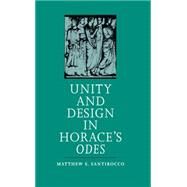Unity and Design in Horace's Odes
, by Santirocco, Matthew S.- ISBN: 9780807816912 | 0807816914
- Cover: Hardcover
- Copyright: 6/1/1986
Horace's first three books of Odes, published together in 23 B.C., are a masterpiece of Augustan literature and the culmination of classical lyric. Matthew Santirocco provides the first new critical approach to them in English in more than two decades.Drawing on recent works on ancient and modern poetry books and using several contemporary critical methodologies, Santirocco reveals the Odes both as individual poems and as components in a larger poetic design. His reading of Horace demonstrates that the ensemble is itself an important context for understanding and appreciating the poetry.Reconstructing the history of the ancient poetry book, both Greek and Roman, Santirocco challenges certain common assumptions about its origin and development. He argues that true parallels for the Odes are not to be found in the other Augustan books, which are relatively homogeneous in content and form, but in the heterogeneous collections of Hellenistic writers.Odes I-III comprise eighty-eight poems in twelve different meters, and in tone and topic they vary widely. Avoiding the two extremes of past scholarship, which either has searched for a single underlying unity or else has denied any meaningful design, Santirocco uncovers a variety of both static and dynamic structures and shows their relevance to the literary interpretation of the poems at all levels. Ultimately, the composition of a poem and the disposition of the group are shown to be analogous activities. Odes I-III do not constitute a medley of discrete poems but, instead, approximate the unity of a single ode.







